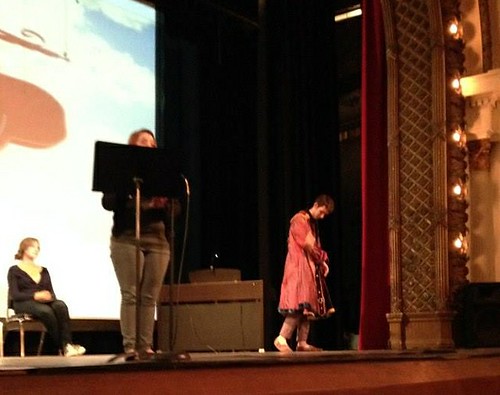Angela’s story. She is 43.
///
The circus curtains in the boys’ room were iridescent. They were beautiful. I wanted to burn them.
The fabric represented such sadness, such a loss, such a complete disaster. I wanted to reclaim the space in a different way. Get rid of all that stuff and start from scratch. I donated them, giving them a chance to be transformed into something happier, to be repurposed.
***
In many ways our story is one of transformation. When I tell it, I usually lose people. Let’s just say that I know what the glaze over looks like.
Our story is so much bigger than vaccinations, but that’s where it began six years ago.
At eight months our son Peter was smiling and babbling. He had no issues whatsoever, and then, after his MMR shot, slowly the smiles and the eye contact faded. The babbling stopped. There was a wall between him and us.
At first we joked, “He takes being a baby very seriously.”
When he was three he would take blades of grass, lay them on the front porch, and make the alphabet. He was really into the letters F and H.
We were thinking, “We have a genius on our hands!” The last thing on our minds was a disability.
Then we got the phone call from the preschool.
Peter was sensitive to loud sounds. If another child cried or screamed, he would go for their faces. That’s what happened. He had a fingernail that we hadn’t rounded off. There was blood. It wasn’t good. Peter was kicked out of school.
There was something in my soul that said, “They’re right. Something is wrong with Peter.”
He lined things up. He spun in circles.
In many ways his younger brother, Tommy, became the older brother. Tommy began to speak for Peter in a beautiful, beautiful way. Even though Peter would get violent and want kids to get away from him, he would let Tommy stay in his face and always bring him toys. It was so lovely.
I would put on movies for the kids, and I’d look for hope on the Internet. I’d Google “social and emotional delays” and always arrived at the A-word, autism. It’s heartbreaking to see your child, who is your heart and soul, reduced to these little behaviors. You start to ask, “Is this blade-of-grass thing my child or autism?” I felt like I didn’t know Peter any more.
Years before, I had received a Christmas card from a friend I had lost touch with. It said that her son was diagnosed with autism, and gave an update of how they were trying a special diet. I thought she was so out there. Autism is autism.
So I called my friend on the phone and told her about the preschool. I described his behavior and I asked about the diet, which she told me had cleaned up a lot of her son’s behaviors.
I was standing up talking on the phone and I felt my sense of gravity leave, and I just went on my knees. She said, “Well, he really craved milk.”
Before that I wouldn’t have thought anything of it. We’re good American parents. We give our kids milk. But Peter was putting away a lot of milk, obsessively so. Rubbing the refrigerator. Always, ”Milk, milk, milk.”
The thought is that some kids have leaky guts. Casein is a protein in milk that if it gets in the blood, it acts like morphine. If that happens, the kids kind of act like they are stoned.
It was so simple to try, so we tried it.
The next ten days were staggering. We saw our son go through the equivalent of a heroin withdrawal. He got the shakes, slept all day, and woke up with raccoon circles under his eyes. It would have frightened us to death, but language, original language came in like gangbusters at the same time. Five to twelve word sentences. Stuff we couldn’t believe.
We watched our son come back to us. It’s almost like we were meeting him for the first time. He was saying, “I love you.” There were all of these Hallmark card moments happening ten times per day.
The first little tiny thing we tried was a jackpot. We were like, “What else ya got?”
I made an appointment with a very well respected pediatric allergist. I shared this whole story with him. At this point we had no clue we were part of some counter-culture movement.
He looked at me and said, “I believe that you believe that happened, but it didn’t happen.”
***
The company line of mainstream medicine says that what happens in digestion can’t affect our brains whatsoever.
They don’t believe it.
My husband had been through medical school. He was so proud of that. But this one aspect—our child’s health—was not supported by anything he was taught.
Doctors are taught to medicate, not to fix with nutrition.
We know there are people out there who don’t believe in the diets or the shots. We have so much compassion and solidarity and deep feelings for folks who are walking this road. But we can’t even begin to have a conversation with many of them because they don’t believe in the shots thing. This story is not their story.
Our reality was very different.
There’s a lot of discussion about accepting, about aides, and wills, and we just can’t be a part of that. We ran and said, “Autism? Make it go the hell away.”
Biomedical intervention believes that autism is reversible. We believe that all people on the spectrum can improve by trying some of these things and some will recover.
We are not unique. There are so many stories of families, but we are “anecdotal evidence.”
With autism, you become the doctor. You become the specialist in your child. But a lot of people can’t make that shift. People are so willing to turn over the power to the therapists, the experts, and the doctors. That voice inside of you has to be the guide.
The children are leading us. There is something that this whole epidemic is telling us as parents and as a nation.
We believe there is this multi-faceted chemical-induced thing that is happening and then something sets it over the edge. Vaccinations, food, pesticides, exposure to heavy metals, all of these things can add up to autism.
We tried everything: stem cells in Ecuador, heavy metal detox, homeopathy, even a shaman. We dove in deep and maintained this idea of never arriving, and that we would just keep looking, hoping, and believing. And we constantly saw progress.
The real traditional piece that we did was the ABA. It put us in charge. It taught us how to maneuver him. How to control his will; his strong will that controlled our lives.
Peter started first grade with a full-time aide in a mainstream classroom, by third grade he had been accepted into a program for students with high abilities.
Things were going great, and that’s when the unthinkable happened.
***
Tommy, almost three, our baby boy, Peter’s number one therapist, died unexpectedly.
He just had a cold, went to sleep, and never woke up. We have no idea what happened. One day he was here and one day he was gone.
It was during that really dark period when we started to see the value of autism. You try to come out of your own dark reality and think, “How can I guide my son who has lost his brother? How is this going to affect his psyche?”
But Peter was fine. He had his movies, his Lego’s. He was never that bonded with Tommy because he was kind of removed, getting better, but removed. They did interact. They would throw rocks in the creek together on the farm, but it was sort of one-way.
That was an intellectual and emotional shift to say there was value in autism. That it was protecting him from this horrible loss. He was going to be okay.
The autism journey brought my husband and me together. We began to find a way of coping, and since coping was already an integral part of our relationship, autism prepared us for the grief. Coping and healing were woven into our fabric already.
***
The love that we’ve felt in the Muncie community is overwhelming. Our community is now so much at the theatre.
There was a guest director from Ball State directing Joseph at the Civic Theatre. Peter was eight. He got in the show even though there were only a few spots in the children’s choir. My husband got in, and I was cast as Potiphar’s wife.
So we’re all in Joseph. Life was good. Life was getting better. We were hopeful.
We were trying on our costumes for the first time, and we were all having fun. I was practicing my dance when I turned around and the kid who was playing Joseph had just put on his coat for the first time. He was preening and swirling and the coat was flying around.
The coat was made of my circus curtains from the farmhouse, which I forgot I had donated.
I felt punched in the gut, and I couldn’t breathe. Here was this fabric that represented such tragedy. And there it was transformed into this beautiful, beautiful thing that was also part of our new story and part of our transformation. It was just amazing.
Every night through the rehearsals and the performance, I felt like everyone was where they were supposed to be. It was so magical.
Our autism journey gave us a belief in healing, and then the grand challenge became can we heal from the loss of Tommy? But that’s sort of what we do. We believe in healing.
We can heal. We can be transformed. The more we open up ourselves to this idea of healing, the truer it becomes.
There’s no part of the words autism or death that isn’t painful.
It’s okay if you cry. It’s good. It’s part of it. It’s part of the sadness and the sweetness. It’s all tied together.
The tears honor the journey.
Watch the reading of Angela’s story.
///
As told to Kelsey Timmerman.
Kelsey is a co-founder of The Facing Project and the author of Where Am I Eating? and Where Am I Wearing?
This story originally appeared in Facing Autism in Muncie, Indiana, a publication of The Facing Project that was organized by Interlock in Muncie, Indiana.


